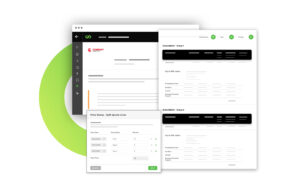MRR Forecasting Drives Confidence in SaaS Financial Planning

Budget guesswork slows SaaS growth. MRR forecasting gives finance leaders real-time visibility into guaranteed renewals, at-risk revenue, and upside potential. With churn-adjusted models and scenario planning, you replace reactive decisions with predictable cash flow and strategic growth.
Why Is Traditional Forecasting a Risk for SaaS Companies?
Most finance teams still rely on spreadsheets or static dashboards to project revenue. But in subscription-based businesses, those models fall short.
- Contracts can churn unexpectedly
- At-risk customers may be saved with the right intervention
- Upside revenue from expansions or new bookings is often overlooked
This uncertainty disrupts hiring decisions, delays investments, and erodes confidence in financial planning. Recurring revenue forecasting changes the game.
What Is MRR Forecasting and Why Does It Matter?
MRR forecasting is the process of breaking monthly recurring revenue into segments based on renewal likelihood. Unlike static reports, it’s dynamic and forward-looking:
- Guaranteed Renewals (Revenue Floor) – Multi-year contracts, auto-renewals, and high-usage customers who are almost certain to stay
- At-Risk Revenue – Customers with uncertain renewal behavior
- Expansion and Upside – Expected upgrades, expansions, and pipeline opportunities
By segmenting revenue this way, you can forecast cash flow with precision and take proactive action to hit your targets.
How Does MRR Forecasting Work in Practice?
1. Identify Your Revenue Floor
Guaranteed renewals form the baseline of your forecast. Knowing this number allows you to:
- Cover fixed expenses with confidence
- Anchor your minimum monthly revenue expectations
2. Model At-Risk Revenue
At-risk accounts require special attention. These customers may be disengaged, not using key features, or late on payments. With churn-adjusted revenue models, you can:
- Assign renewal probability scores
- Adjust forecasts based on account health
- Trigger targeted retention plays
3. Incorporate Expansion and Upside
Upside revenue includes pipeline opportunities, planned expansions, and potential mid-cycle upgrades. Build both best- and worst-case scenarios into your forecast so leadership understands possible revenue ranges.
Why Are Churn-Adjusted Models Critical?
MRR forecasting is powerful because it accounts for churn probability, not just revenue numbers.
- Predict revenue loss scenarios if specific cohorts churn
- Assign probability scores based on behavior, usage, and contract type
- Focus retention resources on the accounts that matter most
This operationalizes forecasting and turns churn into a manageable variable.
How Is Recurring Revenue Forecasting Better Than Static Reports?
Static reports tell you what already happened. MRR forecasting shows you what’s about to happen. Modern recurring revenue forecasting tools provide:
- Real-time visibility into revenue health
- Scenario planning for board and executive updates
- Data integration with CRM, billing, and product usage systems
- Automated churn-risk modeling for better accuracy
With this approach, CFOs can plan with confidence instead of reacting at month-end.
MRR Forecasting vs Traditional Financial Forecasting
Approach | Traditional Forecasting | MRR Forecasting |
Data Source | Static spreadsheets and reports | Real-time integrations (CRM, billing, product usage) |
Churn Visibility | Limited | Adjusted for churn probability |
Revenue Segmentation | One-size-fits-all | Guaranteed, at-risk, and upside segments |
Forecast Accuracy | Low | High |
Decision-Making | Reactive | Proactive |
Frequently Asked Questions (FAQs)
What is MRR forecasting?
It’s a forward-looking model that segments monthly recurring revenue by renewal likelihood, churn risk, and growth opportunities.
Why is MRR forecasting important for SaaS CFOs?
It enables precise cash flow planning, reduces last-minute surprises, and improves confidence in financial decisions.
How do churn-adjusted models improve forecasting accuracy?
They factor in the probability of accounts churning, allowing for more realistic revenue projections.
Can small SaaS companies use MRR forecasting?
Yes. Even simple segmentation (guaranteed, at-risk, upside) improves visibility.
Which tools support MRR forecasting?
Recurring revenue forecasting platforms, advanced CRMs, and analytics tools integrated with product usage and billing systems.
Related Posts

Price Ramping Maximizes Lifetime Value with Scalable Pricing
Price Ramping Maximizes Lifetime Value with Scalable Pricing Instead of locking customers into flat rates, Price Ramping lets you build subscription contracts that grow over time. By aligning pricing with customer value and usage maturity, you remove friction from deal closure while expanding revenue predictably. This feature is crucial for

Stop Training Reps on Product Rules—Let CPQ Do It For You
Stop Training Reps on Product Rules—Let CPQ Do It For You Reps Shouldn’t Memorize Product Rules—They Should Sell If you’re constantly teaching reps what they can’t quote, you’ve got a tooling issue—not a training one. With CPQ product rule automation, reps quote faster, avoid errors, and learn configurations as they

Renewal Based Upselling Turns Every Contract into a Growth Moment
Renewal Based Upselling Turns Every Contract into a Growth Moment Most SaaS companies treat renewals as a checkbox—but that’s a missed revenue opportunity. Renewal-based upselling embeds upgrade options directly into renewal workflows, driving higher ACV, better customer satisfaction, and faster upsell cycles. The key? Use contextual visibility, pre-built upgrade paths,
Ready to fix leaks, speed up quoting, and unlock hidden revenue?
Use our RoI Calculator to see where your business can grow next.


